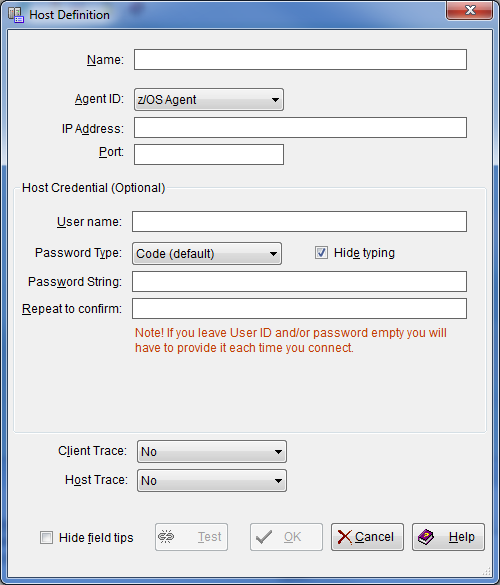

After starting the Windows Client you need to connect the Windows Client to the z/OS server component. In order to connect the Windows Client to the z/OS server component, you must first define the z/OS server or servers that you plan to use. The Windows Client Host List feature is used to define z/OS server connections.
You can define as many z/OS servers as you want and you can simultaneously connect to as many z/OS servers as you want (as long you have installed and configured the z/OS server component on them).
To define a z/OS host
Note: The following procedure assumes you have started the Windows Client and the Host List window is not displayed. If the Host List window is already displayed then you can skip step 1.
The Host List dialog appears as shown in the following sample.

 ) in the Host List window toolbar.
) in the Host List window toolbar.
The Host Definition dialog appears as shown in the following sample.

Provides the Host Name displayed in the Host List dialog.
Provides the name of the agent that collects data from the host. Select z/OS Agent if it is not already displayed.
Defines the IP address or server name of the z/OS host to which you are connecting.
Defines the port number of the z/OS host to which you are connecting.
(Optional) Provides the user ID, which is sent to the host in encrypted form. If you leave the user name, password, or both fields empty, you will have to provide them each time you connect to the host. However, if the host will be used in scheduled operations this information is required.
Select the password type in the Password Type drop-down list. The host definition supports the following types of passwords:
The password is and ordinary password of up to 8 characters.
The password is a passphrase between 9 and 100 characters.
The password is a token + PIN combination.
(Optional) Provides the password string, which is sent to the host in encrypted form. If you do not specify a password string then you must enter it every time you try to connect the Windows Client to the z/OS host.
Note: You also have the option of providing the z/OS host user ID and not the password when setting up your Host Definition; this is often done at sites where security policies require Passwords to be changed periodically. If the host will be used in scheduled operations, the password string is required.
Renter the password string. If you provide a Password String then you must provide the same password string in the confirmation field.
(Optional) Indicates if the system should save the messages relating to host-client communication in a log file. For more information about this field click the Help icon. Normally you will only select this if requested to do so by CA Support.
(Optional) Creates a trace on the host of all the messages exchanged between the z/OS host and the Windows Client. For more information about this field click the Help icon. Normally you will only select this if requested to do so by CA Support.
The Windows Client advises you if your connection to the z/OS host is successful.
The Windows Client stores the host definition. The new host definition appears in the Host List window. The Host List window displays all your defined hosts and their connection status.
The following is a sample of the Host List window showing the different connection status icons.

|
Copyright © 2011 CA Technologies.
All rights reserved.
|
|